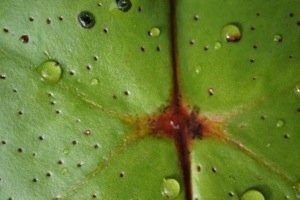Images of a giant- the Amazon water Lily
The Giant Amazon water lily (Victoria amazonica), is found only on the mainstream flood planes of the Amazon river and never deep into tributaries. The Amazon water lily inhabits seasonal flood plane meadows and lakes found on the very channel influenced yearly by rains coming from the distant foothills.
note a new flower head emerging from underwaterThe lily consists of huge flat green pads sometimes over eight feet in diameter!
The pads are attached to a very spiny stalk borne from the center of the lily where a large edible tuber can be found.
Every inch of the lily except for the surface of the pad and the flower petals themselves are completely covered with very sharp spines. Everything here in the amazon has a defense against predators or in this case aquatic grazers.
The flower of the giant lily can be over one foot in diameter with white petals and a splash of violet on the tips. The flower goes through a chromatic transformation as it matures and is pollinated.A new flower head
full bloom first dayclose up of petal tips
Probably the most interesting thing about the giant lily is the way it is pollinated. Here in the Amazon there are many symbiotic relationships between plants and insects but this by far is one of the most outrageous!
scarab beetle pollinator on mature flower head First nightThere exists a special scarab beetle that is the only pollinator for the giant lily. After the flower opens, it releases certain pheromones that attract the beetle to the flower. During the night time hours, the beetles unite inside to feed on soft flower parts. The flower actually closes the beetles for 24 hours. The flower weakens and the beetles are free to fly off to another flower to feed on and pollinate.
almost completely closed trapping the beetles
fully trappedWhere does the beetle benefit? Aside from feeding on lush inner flower parts of the lily, the flower actually heats up the beetles making them more physically active to feed and reproduce in the time they are sequestered. This is called thermogenesis in the biology of the water lily, most likely originated in the Cretaceous era along with a few other plant species that heat up to specifically attract scarab beetles. The heating up not only makes the scent of the flower carry more, but gives a direct energy trade off to the beetles.Many people ask how much weight can they hold? It really depends on not breaking the leaf surface. It could probably hold over twenty kilos with the correct set up underneath. Please do not ask us to get a photo of your child on the pad, we will not humor that request.Three more close ups of the pad itself,
These lilys are very common in the area that we operate and are one of the favorite sights for many visitors. Although we have a few growing on the grounds of the lodge, we still take excursions into flood plane lakes where we can see them blanket the surface of the water like a finely kept aquatic golf green for forest pixies.Otorongo Expeditions













